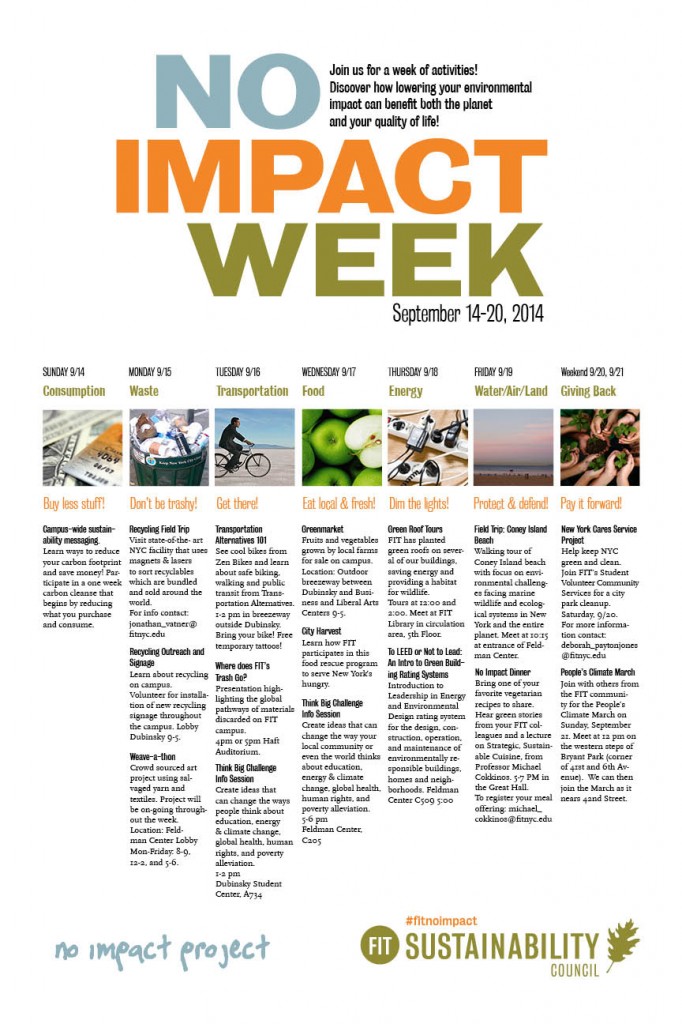As mentioned in Ashley’s post, this Week is No Impact Week. Yay! As a total corporate social responsibility nerd, and events director of the CSR club, I was thrilled when I found out that FIT was adopting this week. Initially inspired by Colin Beaven, a New York City professor who wanted his family to eliminate their carbon footprint for an entire year. Afterwards, he wrote a book and made a documentary about it create family that wanted to live for a year and not negatively impact the Earth. Impact can be a variety of things, pollution, adding to the carbon footprint, littering or not properly disposing of trash, constantly and consuming, and one of my favorite, eating.
This is a topic that many don’t even factor in when thinking about sustainability. I interviewed Professor Cokkinos and Professor Pearson, both active members of the FIT’s Sustainability Council. SN: The Sustainable Council is looking for new student members to help FIT’s sustainability mission, help organize and plan events around the campus, etc. The council also gives grants to student’s sustainable projects. Who doesn’t love free money?)
Since Professor Cokkinos is the faculty member of The Culinary Arts Club, so I asked him what sustainability eating really means: He responded with this great example.
“Think about all the waste that goes into eating a hamburger at McDonald’s. When you order a meal half of what you get is, the plastic cup, the wrapping to the burger and fries and then the huge bag in comes in, all gets thrown away. Half of what you get you don’t eat, not to mention all the practice of cutting down rain forests for cattle grazing that McDonald’s does. For a little more students could go to a sit down restaurant, where they’re given food on a plate that can then be washed as opposed to tossed down the garbage.”
And if you’re still not convinced, just take a look at this raw recipe for Mexican Gazpacho.
Raw recipes are low impact because you can choose organic, seasonal, local produce, that did not travel hundreds of miles and keep your flavor high and your carbon footprint low by not cooking it. Keeping it raw also preserves all of the healthy nutrients for maximum nutrition. It is also part of a great detox and weight loss program. Not to mention it tastes great! You can’t loose.
• 2 1/2pound, about 4 large ripe tomatoes, preferably from your local green market
• 2 jalapeno chiles, seed removed (unless you are feeling adventurous)
• 4 garlic cloves,
• 1medium (10-ounce) cucumber, peeled
• 1/3cup chopped cilantro
• 1/2small white onion, finely chopped
• 1 1/2cups croutons (try yesterday’s bread toasted and cubed)
• 1/4cup quality vinegar (I like ARLOTTA BALSAMIC)
• 1 thick slice stale bread (this is optional for a low carb version)
• 2tablespoons extra virgin olive oil
• Sea salt to taste
• Place everything in the blender except for the croutons. Wiz it up keeping some chunks for texture. Chill the gazapacho and serve in frozen coffee cups or glasses, garnished with the croutons. Another sustainable, green cuisine bonus comes when clean up is just rinsing the blender instead of running the hot water down the drain doing all kinds of dishes.
For more information about joining Culinary Arts Club contact [email protected]
If you want to read more about FIT’s entire No Impact Week check out the full length article I wrote for September’s issue of W27.
Lastly, here is the link to the Sustainable Council: http://www.fitnyc.edu/8604.asp
All things Color, Love, & Fashion,
Ayanna L.

